How to Make Fondant Stick to Ganache
This post may contain affiliate links to products I recommend. I receive a small commission at no cost to you if you make a purchase using my link.
If you’re applying fondant to a ganache covered cake, you’ll need to know how to make the fondant stick to the ganache. In this post, you’ll learn five different ways to attach fondant to ganache, when to choose each option, plus the pros and cons of each.
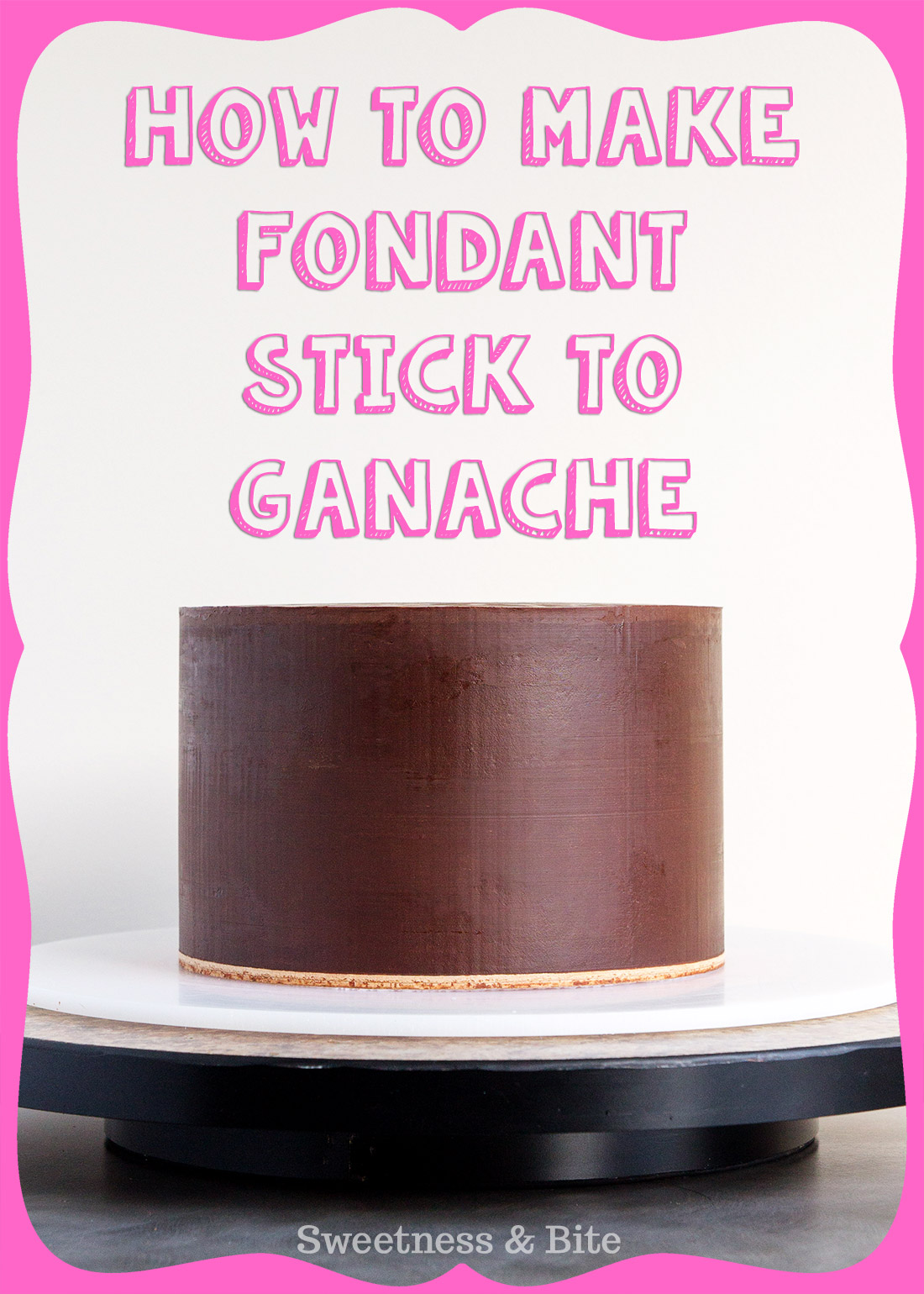
Options.
In general, I enjoy options. It’s nice to have a choice. But sometimes choosing is hard. So that’s when it’s nice for someone to tell you how to make your choice.
If you’ve ever wondered how to make fondant stick to ganache, then this post is for you. I’ve listed a few common things that can be used to make fondant stick to your perfectly ganached cake, and some of the pros and cons of each one to help you make your choice.
Back to the fondant sticking business.
First off, you’ll need to cover your cake in ganache. If you’re new to ganache, check out my How to Ganache a Cake tutorial, which will tell you everything you need to know about making and using ganache, and getting lovely smooth straight sides on your cake.
Then you need to let the ganache-covered cake set overnight at room temperature, or at the very least for a few hours. It will also slightly dry out the surface of the ganache, which makes a nice shell on the cake and helps you keep your nice sharp edges once you apply the fondant.
Next, choose how you’re going to apply your fondant to the cake. You can either cover it the traditional way in one large piece, or you can wrap the cake with fondant.
Now, it’s time to make the fondant stick. All of the below options will do just that, but they all have pros and cons that may determine which one you’d like to use for a specific cake. So, it’s time to find your perfect match…
How to Make Fondant Stick to Ganache
Crisco (or other soft shortening)
Shortening is a vegetable fat, often used in baking or to make a more stable buttercream.
How To Use: Rub a thin layer of shortening onto the surface of the cake. You can use your (clean, or gloved) hands or a pastry brush. Crisco is a soft shortening, but if you’re using a different kind that is more solid at room temperature, you may need to soften it in the microwave.
Pros:
- Doesn’t dry out – you can rub it on before you start rolling out the fondant.
- Is more forgiving if you have trouble covering the cake and need to remove the fondant to try again. The Crisco allows you to peel the fondant off without damaging the ganache underneath. This generally means that not much ganache will be on the fondant so you can re-knead it and try again.
- Absorbs into the fondant – you don’t notice it’s there when the cake is cut, and you won’t taste it.
- Fills in small holes/dents/imperfections in the ganache, leading to fewer air bubbles under the fondant. This is why it’s my preferred choice for covering carved cakes.
Cons:
- Some people dislike the idea of shortening in general, from baking with it to using it in buttercream.
- Soft shortenings like Crisco can be hard to buy in some countries. In New Zealand, very few shops stock it, we pretty much have to buy it online.
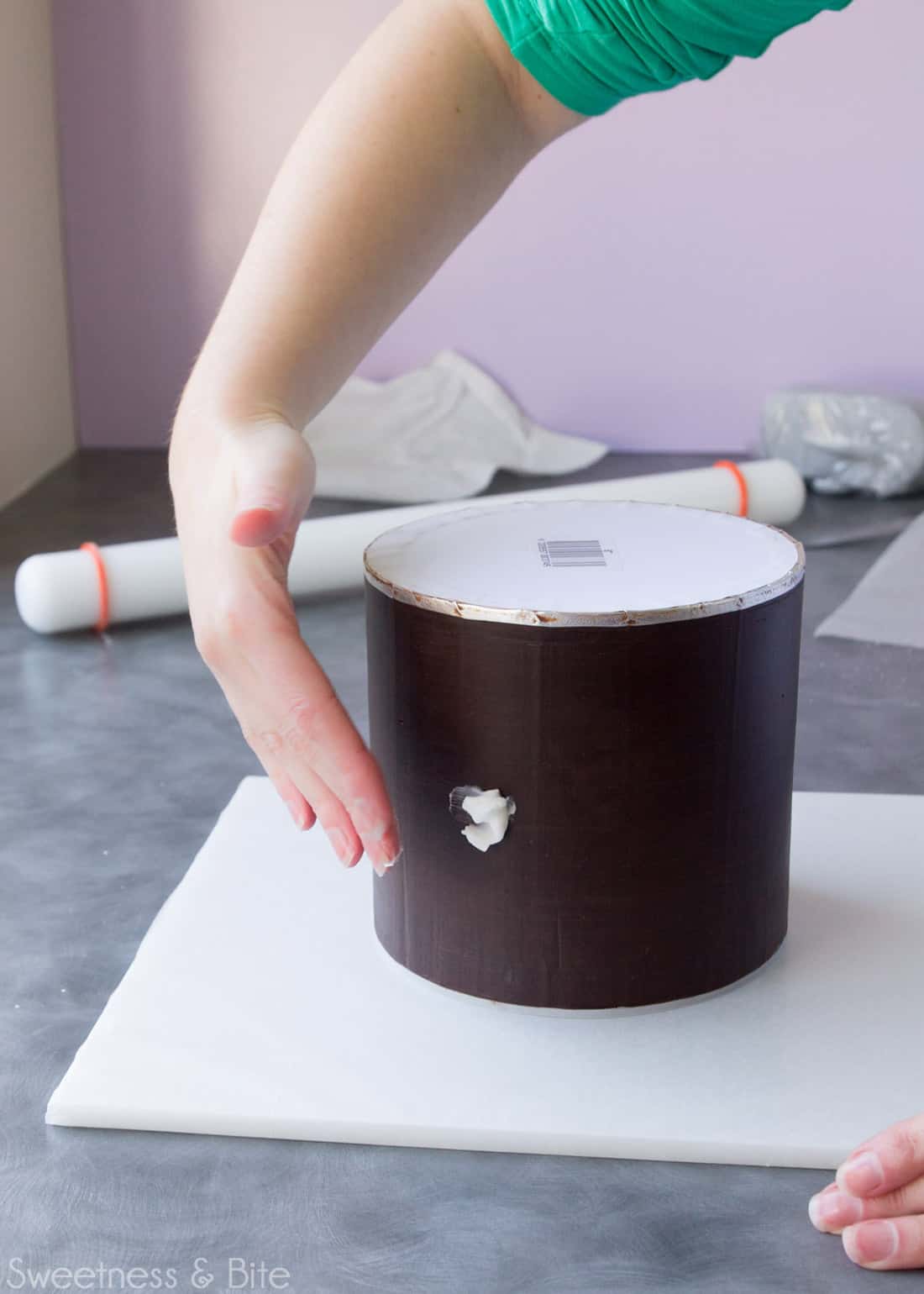
Water
How to Use: Boil and cool some water. Brush or spray onto the surface of the cake.
Pros:
- Everyone has it on hand.
- Can be sprayed on with a spray bottle making for easy application
Cons:
- Can dry out – depending on the humidity in your kitchen, if you brush it on before you start rolling out your fondant, the water may evaporate before you’re ready to apply the fondant. This means you may need to brush it on once your fondant is already rolled out, which can mean your fondant starts drying out and is more likely to crack and get elephant skin while you’re smoothing it on the cake.
- Can leave marks on the fondant if you get the water on your hands and then touch the fondant, the water starts to dissolve the sugar in the fondant and leads to watermarks that can’t be removed.
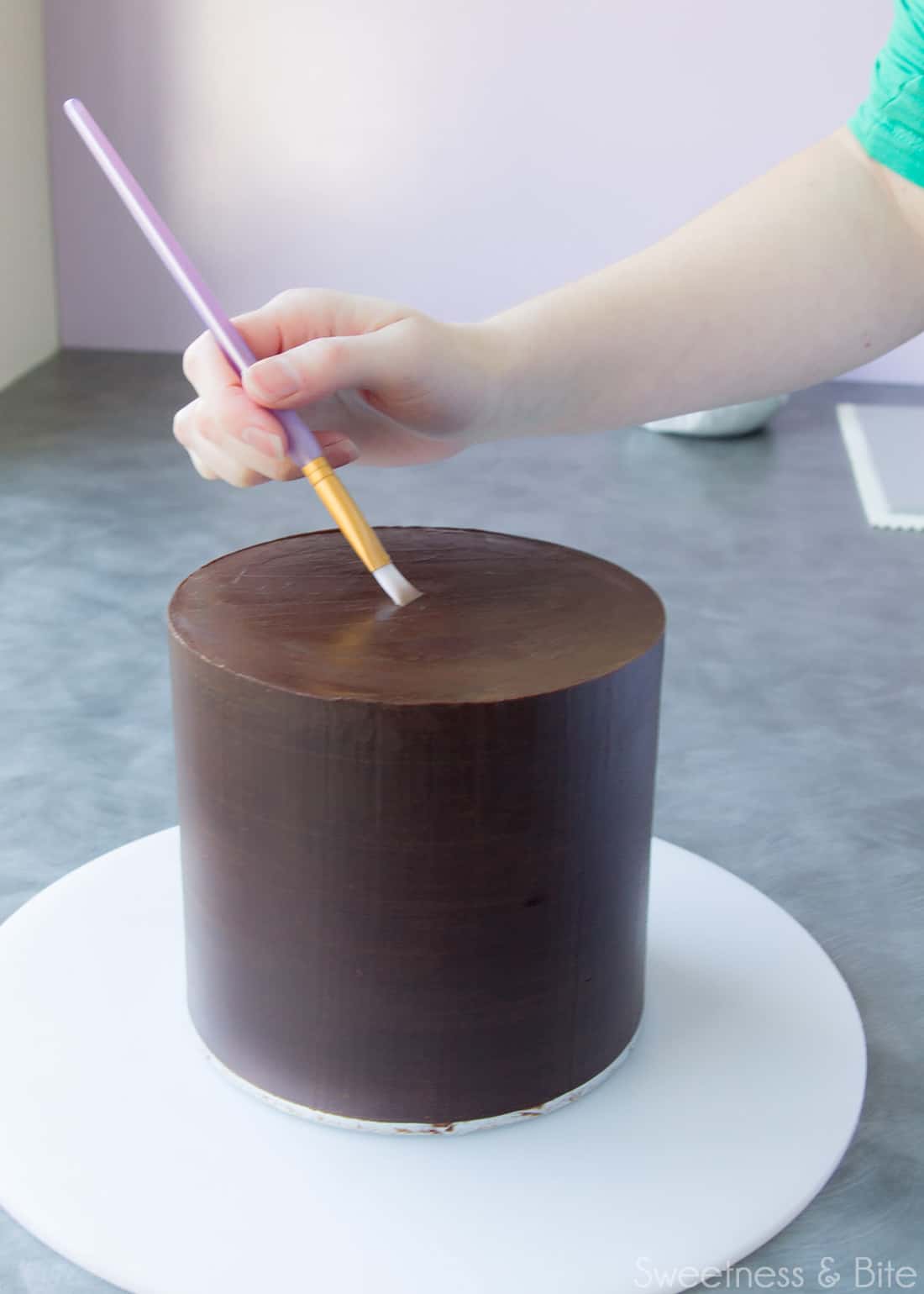
Vodka
How To Use: Brush or spray onto the surface of the cake.
Pros:
- Can be sprayed on with a spray bottle making for easy application
- Tends not to leave marks on fondant like water does. If you’re wrapping a cake in fondant or applying stripes, if the vodka seeps out it will dry quite well without leaving obvious marks.
- The higher alcohol content helps to sterilise the surface of the cake.
Cons:
- Evaporates quickly (much more quickly than water) so it needs to be brushed on just prior to applying the fondant, which again means the fondant can start drying out before you even get it on the cake.
- Some people prefer not to use alcohol on cakes for religious or other personal reasons.
- The cost of vodka can be prohibitive, depending on where you live and where you buy it (I just buy the 1-litre bottles when they’re on special, as I use it for other cake decorating uses like painting, cleaning brushes and wiping down cake boards. Oh, and making vanilla extract)
Sugar Syrup
How To Use: Make a sugar syrup (also known as “simple syrup”) by boiling together equal parts sugar and water until the sugar dissolves, then cool to room temperature before use. Spray or brush onto the surface of the cake.
Pros:
- Nice and tacky, can mean fewer air bubbles as the fondant is well adhered to the ganache.
- You can make a large batch and store it in the fridge for several weeks.
Cons:
- Needs to be made and cooled before use.
- Tends to stick very well to the ganache, meaning if you need to remove the fondant and try again, there can be a lot of ganache marks on the fondant.
- Because it’s super sticky, there is more likelihood of damaging the ganache if you need to remove the fondant, which can mean the ganache needs touching up before fondant is reapplied.
Thinned-Down Jam
How To Use: Make a jam syrup by thinning down apricot jam with cooled, boiled water. Strain through a sieve to remove any lumps. Brush onto the surface of the cake.
Pros:
- Like sugar syrup, it’s nice and tacky.
- Easy to make
Cons:
- As above with the issues with fondant.
- Needs to be made.
- The jam flavour (usually apricot) doesn’t necessarily go with all cakes.
So there you have five options for to make fondant stick to ganache. Hopefully, it’ll help you make your choice. If you’ve got another option I’ve missed that you’d like to share, please let us know in the comments below.
Happy, er, sticking!
~Natalie
xx

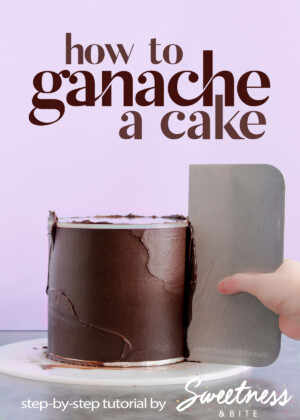

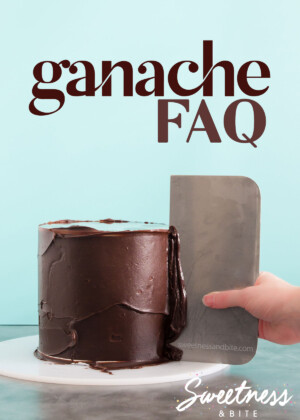
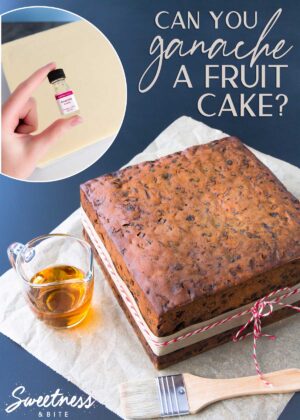
Thanks for the tutorial! Will another one be applying fondant to the cake?
I’ve seen and used clear piping gel that comes in the small tubs. Brush it on nice and thin, completely covering the area you are covering with fondant, and apply the fondant. I’ve never had to reapply fondant on ganache (plenty of practice runs beforehand) so I’m not too sure if the gel causes the ganache to stick to the fondant if it needs to be removed and reapplied. I’m sure someone will know the answer to that though.
Hi Adam. Thanks so much for that, I’ll have to give the piping gel a go sometime and see how it works. I’m just terrible at fondant, so I frequently have to reapply 😉
Hello, love your ganache tutorial….you are pure inspiration. Cakes are so heavy how are you physically able to flip them? …the thought terrifies me. What % of heavy cream do you use? What brand of scraper and turntable are you using?
Hi Janis ? You’re right, cakes get pretty darn heavy. For ones I don’t think I can comfortably flip, I usually ask someone stronger than me (which is pretty much anyone, I’m a weakling 😉 ) to flip it for me. For really enormous cakes (which I don’t do often anymore), I find it best to skip the flipping altogether, although it doesn’t give me quite as level a cake and the edges take a bit of extra work. I use the same technique up until the flipping, then spread a thin layer of ganache over the top of the cake, place the piece of baking paper on top, then put another cake board on the top and place the spirit level on top, a press around the cake as you would it you had flipped it to make the cake level. Then remove the board on top and put the cake in the fridge for a bit. You’ll be left now with a ridge of ganache around the side of the cake along the top, so once you peel the baking paper off you’ll need to warm a scraper up under hot water and use it to gently scrape away that ledge. You may have to use your spatula to fill in any little gaps or uneven bits, and scrape again. It just takes a bit of extra tweaking to get the edge right. Hopefully that makes sense!
I use standard whipping cream here in New Zealand, which is about 35% fat. You could use a cream with a slightly higher fat content, but I wouldn’t go any lower or you’ll possibly have problems with the ganache splitting. My stainless steel scraper was a gift from a friend so I’m not sure where she got it, but these stainless steel scrapers are similar (if a little thinner than mine). The brand is Sugar Crafty, I’m sure you can buy it from other websites too. My turntable is one I bought from a cake supply place years and years ago, it was unbranded (and unfinished, I had to get our kitchen builders to put the black edge on it for me, it was raw MDF before that!). Any heavy, level turntable (or lazy susan) that turns smoothly will do the trick though 🙂
Hi! When you apply crisco on ganache for fondant to stick on, have you ever encountered any peeling off of the fondant from the ganache due to the fondant not sticking properly? I’m thinking of trying your method of apply crisco for an upcoming cake but worry that the fondant will peel off by itself after the next day. 🙂
Hi Faithy, nope I’ve never had that happen. I have far fewer issues with fondant not sticking (and also far fewer air bubbles trapped under the fondant) since I switched to using the Crisco. The Crisco seems to eventually absorb into the fondant, but by the time that happens the fondant has dried and firmed up on the cake, so it won’t peel off 🙂 Hope that helps.
Thank you Natalie! 😀 I will try! I too am always stressed out covering cake…and I hate it when elephant skin forms when I am so slow in covering…
Hello, what a fab “to the point” tutorial. I have been making cakes for a year now and still learning, I did not know that I had to leave the ganached cake out of the fridge for a couple of hours to dry, this would explain why my lovely neat edges get warped!! Thank you.
I have the same issue with buttercream covered cakes, I take them out the fridge, apply crisco (I think I have way too hot hands (live in scotland so not super hot)). My edges go rounded after applying crisco and then adding fondant. Any ideas?? Some customers do not want ganache on their victoria sponge cake, which I totally understand.
I’ll look out for some more of your blogs / tutorials.
Julie, Cake That, Bothwell, Scotland
Hi Julie. I understand that too, when it comes to eating cake, I’m a buttercream girl 😉 The key I think with putting fondant on buttercream is that the buttercream needs to be one that sets really firm, and you do need to work super quickly. I find with a meringue-based buttercream, because it doesn’t crust it doesn’t really need anything to make the fondant stick to it and the moisture on the surface of the buttercream is enough. If you’re using a crusting buttercream then it might be better to use sugar syrup in a spray bottle to dampen the surface, that will save you rubbing it with Crisco and possibly damaging the surface, or the buttercream softening as you’re doing that. I’ve never had much luck covering a buttercream covered cake in fondant using the all-in-one method, so I wrap them with fondant instead (you can check out that tutorial here . That prevents any squishing of edges. Hope that helps! 🙂
hello
could you please tell me how you apply the crisco prior to fdondant covering. do you melt and brush on or spread like butter.
many thanks.
Louisa 🙂
Hi Louisa, I just rub it on with my fingers, it’s already nice and soft no need to melt. If you have a look at my mini cake tutorial, there’s a picture in that which shows the ganache rubbed with Crisco 🙂
Hi natalie,
thanks for this great informative tutorial. I have a client who has ordered a 14 inch round and 8 inch high cake . i am going to be covering in ganache for extra stability. the cake will be covered in fondant and decorated to look like books around the edge ( so its a lot of fondant and im worried that the weight of the decor on the cake will weigh the fondant down and it will slip off the crisco… any advise? should i put a layer of buttercream on top of the ganache ?! would appreciate your advice!
Hi Lani. I have used Crisco on cakes of all sizes and haven’t had any slip off. However, I think it could depend on how you store your cakes once they’re decorated. I never refrigerate my cakes (apart from during the ganaching process), so once the fondant goes on it dries on the surface, so it’s pretty firm, it’s not going to slide anywhere. However, if you store your cakes in the fridge, the moisture from the fridge (and the moisture that forms on the fondant as the cake comes back to room temperature) mean that the fondant doesn’t really dry out, and I suppose there’s a chance that the fondant could slide. I think it would be highly unlikely, but I don’t want to tell you “for sure, it will be fine” and then have it not be! I would be very surprised if it did though. And if it did, I would think it would have more to do with the actual storage than the Crisco itself.
Buttercream on top of ganache would probably cause more problems than the thin layer of Crisco, so I definitely wouldn’t go that way.
I’ve used the Crisco one some pretty large cakes, including a 9″ tall 9″ round dummy cake that was part of my best friend’s wedding cake, and I actually had that dummy for maybe six months after the wedding, and the fondant never budged.
So long story short, I would be very surprised if you used Crisco on your cake and the fondant slid off, but again I can’t guarantee anything, that’s just speaking from personal experience. I hope it helps somewhat!
Hi. Thank you for this informative post. I have a question. I want to cover a cake with ganache and then put some animal fondant toppers on top of it for decoration. Do you think it will work?
Hi Eli. Yes you can absolutely do that 🙂
Hi Natalie,
Just discovered your website and cannot thank you enough for your straight forward advice!
One question though, Is Kremelta the same as Crisco? (I’m from NZ).
Hiya, you’re most welcome! Kremelta and Crisco are both vegetable shortenings, I haven’t used Kremelta for a long time but I think from memory it’s quite firm at room temperature whereas Crisco is softer. You can still use the Kremelta though, just warm it up a tiny bit in the microwave (not too long or it will melt!). Or if you wanted to try the Crisco, you can buy it online from Kiwicakes or Cakestuff 🙂
Thanks so much for your brilliant advice x
How did you cover the cake board did you use any icing or piping gel?
I usually just brush water onto a cake board when I cover it with fondant. Any of the options in this post will work well to stick the fondant to the board though 🙂
What is your preferred method (based on the ones you listed above) to get the fondant to stick to the ganache?
Hi Sasha, I usually use Crisco, or sometimes I’ll brush with water. But probably 95% of the time I use Crisco 🙂
Hello!
I’ve a ganache cake in freezer now. Will need the ready cake by next Saturday.
Now my problem.. when and how best I can start to take the cake out to put fondant?
Planning to make a barbie cake this it’ll be a fondant skirt.. so Shd I put a layer of white fondant then follow by the colours for the frills around the whole cake?
Thank you!
Hi Mae, I would suggest taking the cake out of the freezer the day before you need to start decorating it. Leave it all wrapped up until it has defrosted, that will keep the moisture in the cake.
If you’re using ganache under the fondant then you can probably skip the extra layer of fondant as the ganache sets firm and won’t get anything messy on the ruffles. You should be overlapping the ruffles so there shouldn’t be any ganache showing when you’re done. But you can do it either way, whichever you prefer.
Hope that helps 🙂
I live in a tropical country it is very warm and humid room temperature. Would you suggest I take the cake out put in the fridge till it defrosted and decorate it cold from fridge?
If that is what you would normally do (decorate cold from the fridge) then yes you should probably do that. It will take a bit longer to defrost in the fridge, so maybe take it out of the freezer a bit sooner. I can’t say exactly how long it will take so you’ll have to use your best judgement on that. After that, you should be able to treat it just like you would an unfrozen cake.
Just keep in mind that when the cake has been in the fridge, your fondant can get a bit sticky when you’re applying it, as the cake warms back up to room temperature, so that may affect your ruffles a bit while you’re working on them. And if you possibly can avoid putting the cake back in the fridge after the ruffles are applied then I would definitely recommend leaving it out, as fondant tends to get sticky and droop when it’s in the fridge, and that could ruin your ruffles. I think there are some brands of fondant that hold up better in humidity and in the fridge, but it’s generally not humid where I live and I don’t usually need to refrigerate my cakes so I’m not overly familiar with which brands work best.
Hi Tell me please if I can do this I’m making a red velvet cake for my granddaughters birthday and I want to layer it with cheese cream filling and cover it with chocolate ganache then partially cover it with a marble fondant wrap with the front not fully covered I thought if I put a full fondant cover on the cake and then the fondant wrap it would be too heavy for the cake Would I need to put skewers in the cake to hold it?
Hi Yvonne. My apologies for the delayed reply, your comment somehow ended up in my spam folder and didn’t get published. I’m so sorry and hope I’m not too late, I will answer anyway just in case I’m not.
My recommendation is to pipe a dam of the ganache around the cake layers before adding the cream cheese – just put your ganache into a piping bag and pipe a ring (1-2cm wide) around the edge of the cake, then put the cream cheese filling inside that. Then cover with the ganache on the outside as you normally would. The ganache dam will set firmly, and stop the cream cheese from squishing out. That way you should be able to add your fondant and the weight shouldn’t cause the filling to bulge. You shouldn’t need skewers unless your cake is very tall (more than 5″ tall), in which case it would be a good idea to put a cake card in between the middle two cake layers with some skewers underneath, which would hold the weight of the layers on top. But if it’s not super tall then it should be fine with the ganache dam.
I hope that helps, if not this time then for next time 💜
Hi Natalie,cn I use food glue to help stick fondant to ganache?
Hi Fazlin, I wouldn’t suggest using edible glue to ganache, it often has a gummy texture once it dries that isn’t very nice to eat in large amounts. If it’s just for small decorations it would be ok, but if you’re covering the cake in fondant, it’s better to use other of the other options mentioned in the post 💜